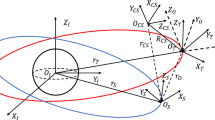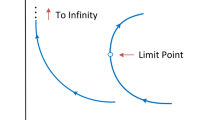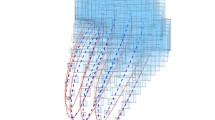Abstract
The dynamic problem of a spacecraft’s (SC) rotation from an arbitrary initial angular position to a given final angular position is considered and solved. The case is investigated when the control is limited, and the minimized functional combines, in a given, proportion, the time of the maneuver and the integral of the energy of rotation. The construction of the optimal control is based on the quaternionic differential equation relating the vector of the angular momentum of the SC with the quaternion of the orientation of the body-related coordinate system. The control law is formulated in the form of an explicit dependence of the control variables on the phase coordinates. The analysis of the special control regime of the SC is carried out. Based on the conditions of transversality, as the necessary conditions for optimality, the optimal value of the kinetic energy of rotation when moving in a special control regime is determined. The created control algorithms allow turning of an SC with a kinetic rotation energy, which does exceed a predetermined level. For a dynamically symmetric SC, the problem of spatial reorientation is solved completely. The results of the mathematical modeling of the motion of an SC under the optimal control are presented, demonstrating the practical feasibility of the developed algorithm for controlling the spatial orientation of the SC.

Similar content being viewed by others
REFERENCES
V. N. Branets and I. P. Shmyglevskii, Application of Quaternions in Problems of Solid Body Orientation (Nauka, Moscow, 1973) [in Russian].
M. V. Levskii, “Optimal spacecraft terminal attitude control synthesis by the quaternion method,” Mech. Solids 44, 169 (2009).
M. V. Levskii, “Use of the energy integral in optimal control of the spacecraft spatial attitude,” Mech. Solids 44, 502 (2009).
M. V. Levskii, “A special case of spacecraft optimal attitude control,” J. Comput. Syst. Sci. Int. 51, 487 (2012).
M. V. Levskii, “Quadratic optimal control in reorienting a spacecraft in a fixed time period in a dynamic problem statement,” J. Comput. Syst. Sci. Int. 57, 131 (2108).
K. B. Alekseev and G. G. Bebenin, Spacecraft Control (Mashinostroenie, Moscow, 1974) [in Russian].
A. I. Van’kov, “Adaptive robust control of spacecraft angular motion using predictive models,” Kosm. Issled. 32 (4–5) (1994).
M. A. Velishchanskii, A. P. Krishchenko, and S. B. Tkachev, “Synthesis of spacecraft reorientation algorithms using the concept of the inverse dynamic problem,” J. Comput. Syst. Sci. Int. 42, 811 (2003).
K. B. Alekseev, A. A. Malyavin, and A. V. Shadyan, “Spacecraft extensive attitude control based on fuzzy logic,” Polet, No. 1, 47–53 (2009).
M. V. Levskii, “About method for solving the optimal control problems of spacecraft spatial orientation,” Probl. Nonlin. Anal. Eng. Syst. 21 (2) (2015).
B. V. Raushenbakh and E. N. Tokar’, Spacecraft Orientation Control (Nauka, Moscow, 1974) [in Russian].
A. V. Molodenkov and Ya. G. Sapunkov, “Special control regime in optimal turn problem of spherically symmetric spacecraft,” J. Comput. Syst. Sci. Int. 48, 891 (2009).
S. Scrivener and R. Thompson, “Survey of time-optimal attitude maneuvers,” J. Guidance, Control Dyn. 17 (2) (1994).
H. Shen and P. Tsiotras, “Time-optimal control of axi-symmetric rigid spacecraft with two controls,” AIAA J. Guidance, Control Dyn. 22 (5) (1999).
A. V. Molodenkov and Ya. G. Sapunkov, “A solution of the optimal turn problem of an axially symmetric spacecraft with bounded and pulse control under arbitrary boundary conditions,” J. Comput. Syst. Sci. Int. 46, 310 (2007).
V. N. Branets, M. B. Chertok, and Yu. V. Kaznacheev, “Optimal rotation of a solid body with one axis of symmetry,” Kosm. Issled. 22 (3) (1984).
S. Liu and T. Singh, “Fuel/time optimal control of spacecraft maneuvers,” J. Guidance 20 (2) (1996).
M. V. Levskii, “The problem of the time-optimal control of spacecraft reorientation,” J. Appl. Math. Mech. 73, 16–25 (2009).
M. V. Levskii, “The use of universal variables in problems of optimal control of the orientation of spacecraft,” Mekhatron. Avtomatiz. Upravl., No. 1 (2014).
M. V. Levskii, “Control system for spatial turn of a spacecraft,” RF Patent No. 2006431, Byull. Izobret., No. 2 (1994).
M. V. Levskii, “Pontryagin’s maximum principle in optimal control problems of orientation of a spacecraft,” J. Comput. Syst. Sci. Int. 47, 974 (2008).
M. V. Levskii, “On optimal spacecraft damping,” J. Comput. Syst. Sci. Int. 50, 144 (2011).
A. P. Markeev, Theoretical Mechanics (Nauka, Moscow, 1999) [in Russian].
L. S. Pontryagin, V. G. Boltyanskii, R. V. Gamkrelidze, and E. F. Mishchenko, The Mathematical Theory of Optimal Processes (Wiley, New York, London, 1962; Nauka, Moscow, 1983).
L. C. Young, Lectures on the Calculus of Variations and Optimal Control Theory (Am. Math. Soc. Chelsea, New York, 2000).
M. V. Levskii, “Device for forming parameters of regular precession of a solid body,” RF Patent No. 2146638, Byull. Izobret. No. 8 (2000).
Author information
Authors and Affiliations
Corresponding author
Additional information
Translated by E. Seifina
APPENDIX
APPENDIX
If an SC turns with the minimum value of integral (1.6), then the SC’s rotation can be stopped for a time not exceeding the known value (under constraint (1.3)), since minimization of functional (1.6) limits the kinetic energy of rotation.
We explain what has been said. The rate of change of the kinetic energy of rotation is \({{\dot {E}}_{{\text{k}}}}\) = L1M1/J1 + L2M2/J2 + L3M3/J3. Under the constraints of (1.3), the optimal control in terms of the rapid quenching of the kinetic energy of rotation is [22]
in which \({{\dot {E}}_{{\text{k}}}} = - {{u}_{0}}\sqrt {2{{E}_{{\text{k}}}}} \) and \({{\ddot {E}}_{{\text{k}}}} = u_{0}^{2}\). To stop the rotation of the SC in the presence of constraint (1.3), the time is required to be not less than \(\Delta t = {{\sqrt {2{{E}_{{\text{k}}}}(t)} } \mathord{\left/ {\vphantom {{\sqrt {2{{E}_{{\text{k}}}}(t)} } {{{u}_{0}}}}} \right. \kern-0em} {{{u}_{0}}}}\). Since during space flight one can stop the rotation of the SC at any time, it is necessary to focus on the value \({{t}_{{{\text{stop}}}}} = {{\sqrt {2{{E}_{{\max }}}} } \mathord{\left/ {\vphantom {{\sqrt {2{{E}_{{\max }}}} } {{{u}_{0}}}}} \right. \kern-0em} {{{u}_{0}}}}\). The solution of problem (1.1)–(1.6) allowed synthesizing the control, which provides the turn of the SC with the kinetic energy of rotation of not more than a2/2a1. If necessary (for example, in the event of a contingency urgently requiring us to stop the maneuver, or in other emergency cases) we will be able to extinguish the angular velocity within a time period of \({{\sqrt {{{a}_{2}}{\text{/}}{{a}_{1}}} } \mathord{\left/ {\vphantom {{\sqrt {{{a}_{2}}{\text{/}}{{a}_{1}}} } {{{u}_{0}}}}} \right. \kern-0em} {{{u}_{0}}}}\), since simultaneously with minimizing integral (1.6) the optimal control (2.12) limits the kinetic energy of rotation during the slew maneuver, and Emax ≤ a2/2a1.
In addition, optimization in accordance with criterion (1.6) minimizes the time the SC’s turns from the position Λ(0) = Λin to the position Λ(T) = Λf in the presence of restrictions Ek(t) ≤ a2/2a1 and (1.3). Let us prove the statement. Recall that
are functional “ways.” Consider the function \({{f}_{0}} = \sqrt {2{{E}_{{\text{k}}}}(t)} \). Accordingly, we have \({{f}_{{\max }}} = \sqrt {2{{E}_{{{\text{max}}}}}} \). Under constraint (1.3), the fastest possible spin-up of the SC occurs during control [22]
for which \({{\dot {E}}_{{\text{k}}}} = {{u}_{0}}\sqrt {2{{E}_{{\text{k}}}}} \) and \({{\ddot {E}}_{{\text{k}}}} = u_{0}^{2}\), and the force moment M and the angular momentum L are equally directed (where |M| = const and \({\mathbf{\dot {M}}} = - {\boldsymbol{\omega }} \times {\mathbf{M}}\)), which corresponds to control (2.12). For the fastest stop of rotation under constraint (1.3), it is necessary to control (A.1), at which the control torque M and the angular momentum L have opposite directions, |M| = const, and \({\mathbf{\dot {M}}} = - {\boldsymbol{\omega }} \times {\mathbf{M}}\), which corresponds to control (2.12). If u0 → ∞, then the acceleration and braking time τ → 0 and during the whole turn Ek(t) = const = a2/2a1.
For any control satisfying constraint (1.3), two conditions are satisfied: f0(t) ≤ u0t if t ≤ T/2 and f0(t) ≤ u0(T – t) if t > T/2 (since L(0) = L(T) = 0). With the same value of the path functional S, the minimum value of T is reached if the time interval when Ek(t) = const = Emax is the longest and the time intervals when Ek(t) < Emax are as short as possible. Control (2.12) satisfies both requirements.
If u0S ≤ a2/a1, then in laws (2.12) and (2.13) t1 = t2 = T/2 \( = \sqrt {S{\text{/}}{{u}_{0}}} \) (relay control with one switching point is optimal); in this case, Emax = u0S/2 and the restriction Ek(t) ≤ a2/2a1 is insignificant. The optimal turn time is Topt\( = 2\sqrt {S{\text{/}}{{u}_{0}}} \).
If u0S > a2/a1, then t2 > t1 (t1 = τ, t2 = T – τ), and the turn with the special control regime is optimal (relay control with two switching points is implemented); τ is the acceleration (braking) time. In this case, with the optimal control (2.12), the pivot time is Topt\( = S\sqrt {{{a}_{1}}{\text{/}}{{a}_{2}}} + {{\sqrt {{{a}_{2}}{\text{/}}{{a}_{1}}} } \mathord{\left/ {\vphantom {{\sqrt {{{a}_{2}}{\text{/}}{{a}_{1}}} } {{{u}_{0}}}}} \right. \kern-0em} {{{u}_{0}}}}\). Of all the possible motions satisfying the conditions of turn (1.4) and (1.5) and constraint (1.3), we are interested in those that have the general property described by the inequality Ek(t) ≤ a2/2a1 with the optimal control (2.12). Whatever the control, the turning time T satisfies the inequality
The right-hand side of this inequality is a monotonically decreasing function of the argument Еmax over the entire segment [0, u0S/2] (Emax cannot be greater than u0S/2 since the value Emax = u0S/2 corresponds to the relay control with one switching point when phase of the SC’s rotation by inertia is absent). Other things being equal, the pivot time is minimal if the path functional S is minimal. Since for all controls of interest to us, Emax ≤ a2/2a1, the right-hand side of inequality (A.3) cannot be less than Topt, since for control (2.12), the path functional S takes the minimum value. As a result, the pivot time is always T ≥ Topt. Note that for a fixed turn time T the minimum value of fmax is \({{f}_{{\max }}} = ({{u}_{0}}T - \sqrt {u_{0}^{2}{{T}^{2}} - 4{{u}_{0}}S} ){\text{/}}2\). Accordingly, the minimum possible value of the maximum energy during turn Emax is
The value Emax is a monotonically decreasing function of the duration of the turn T. If T = Topt, then Emax = a2/2a1. Therefore, if T < Topt, then Emax > a2/2a1. This means that the kinetic energy of rotation Ek(t) does not exceed the level a2/2a1 and the time of the turn must be T ≥ Topt. Therefore, Topt is indeed the minimum possible time of a reorientation under the condition Ek(t) ≤ a2/2a1 and in the presence of constraint (1.3).
If u0 → ∞ then the value of integral (1.6) is G = 2a2T. Consequently, the time of the optimal turn is T = G/2a2 and, minimizing integral (1.6), we obtain the turn of the SC for the minimum time.
Thus, it has been proved that minimization of functional (1.6) leads to the SC turning for the minimal time with the limited kinetic rotation energy, which is important in the practice of a space flight.
Rights and permissions
About this article
Cite this article
Levskii, M.V. Synthesis of the Optimal Control of the Spacecraft Orientation Using Combined Criteria of Quality. J. Comput. Syst. Sci. Int. 58, 980–1003 (2019). https://doi.org/10.1134/S1064230719040105
Received:
Revised:
Accepted:
Published:
Issue Date:
DOI: https://doi.org/10.1134/S1064230719040105




